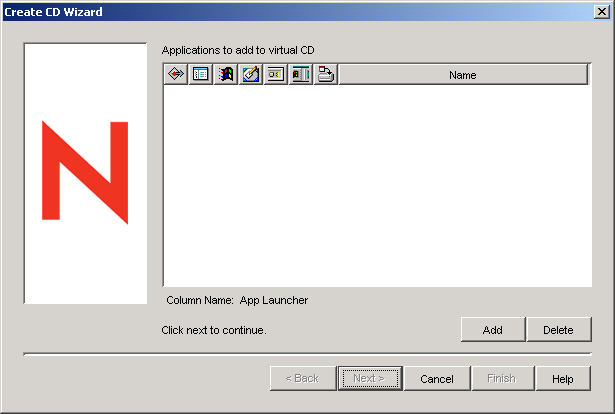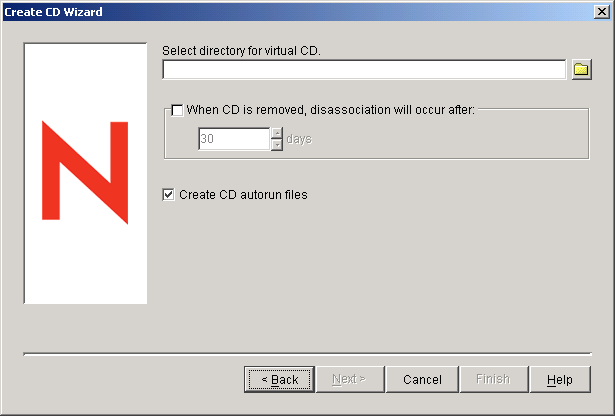50.6 Create Virtual CD
This tool lets you create a cache of applications that can be added to removable media (CD, Jaz drive, Zip drive, and so forth). The removable media functions as a second workstation cache, containing the Application object settings and application source files required to install and run the application. Any user whose workstation has Application Launcher installed can use the media to install and run the applications.
For example, you have a mobile user who seldom connects to the network but needs an application that you've distributed to other users. You burn a CD with the application and send it to the user. The user inserts the CD into his or her workstation's drive, Application Launcher reads the CD and displays the Application object's icon in the places you've configured (Application Launcher window, Start menu, desktop, and so forth). The user then launches the application, which is distributed to the workstation according to the Application object’s configuration.
If the application includes any dependent applications (see Section 37.0, Advanced Distribution: Configuring Application Dependencies and Chains), the dependent applications must be included on the removable media unless they have already been distributed to the user’s workstation.
To create a cache on removable media:
-
In ConsoleOne, click the menu > > > to start the Create CD Wizard and display the following page.

-
Click , then browse for and select the Application object for the application you want to distribute. Repeat this step to add additional applications.
If you add an MSI application, make sure the MSI source directory includes only MSI package files and subdirectories. The Create CD Wizard includes all files and subdirectories located in the source directory, causing Application Launcher to install all of the files and subdirectories regardless of whether or not they are part of the MSI package. The source directory is specified by the SOURCE_PATH variable on the Application object’s Macros page (Common tab).
-
For each application you added to the list, select the locations where you want the Application object's icon to appear and select whether or not you want to force run and force cache the application. These settings are described below:
Force run:
 Automatically runs the application. With a user-associated application, the application is run immediately after Novell Application Launcher™ starts or refreshes. With a workstation-associated application, the application is run immediately after the workstation starts up (initial startup or reboot) or after NAL Workstation Helper refreshes.
Automatically runs the application. With a user-associated application, the application is run immediately after Novell Application Launcher™ starts or refreshes. With a workstation-associated application, the application is run immediately after the workstation starts up (initial startup or reboot) or after NAL Workstation Helper refreshes.
You can use the option in conjunction with several other settings to achieve unique behaviors. For example, if you use the option with the option ( object > tab > page), as soon as the Application object is distributed it runs one time and then is removed from the workstation. Or, suppose that you want to run the Application object immediately one time at a predetermined time. If so, select , select the option on the Application page ( > tab), and define a schedule using the Schedule page (Application object > tab).
App Launcher:
 Adds the Application object’s icon to the Application Window, the Application Explorer window, and the Application Browser window.
Adds the Application object’s icon to the Application Window, the Application Explorer window, and the Application Browser window.
Start menu:
 Causes Application Explorer, if running, to add the Application object to the Windows Start menu.
Causes Application Explorer, if running, to add the Application object to the Windows Start menu.
Desktop:
 Causes Application Explorer, if running, to display the Application object’s icon on the Windows desktop.
Causes Application Explorer, if running, to display the Application object’s icon on the Windows desktop.
System Tray:
 Causes Application Explorer, if running, to display the Application object’s icon in the Windows system tray.
Causes Application Explorer, if running, to display the Application object’s icon in the Windows system tray.
Quick Launch:
 Causes Application Explorer, if running, to display the Application object’s icon on the Windows Quick Launch bar.
Causes Application Explorer, if running, to display the Application object’s icon on the Windows Quick Launch bar.
Force cache:
 Applies only if the Application object is marked as disconnectable (Application object > tab > page). With enabled, the first time the application is launched, Application Launcher copies the application source files and other files required for installation to the workstation’s cache directory. The user can then install or verify the application while disconnected from eDirectory. The files are compressed to save space on the workstation’s local drive.
Applies only if the Application object is marked as disconnectable (Application object > tab > page). With enabled, the first time the application is launched, Application Launcher copies the application source files and other files required for installation to the workstation’s cache directory. The user can then install or verify the application while disconnected from eDirectory. The files are compressed to save space on the workstation’s local drive.
The behavior for a removable media application (described in the previous paragraph) is different than the behavior for a network (eDirectory) application. With a network application, Application Launcher caches the application as soon as it becomes aware of the application, even if the application has not been launched yet. With a removable media application, Application Launcher does not cache the application until the application is launched the first time. This ensures that the user is not required to wait through the caching of multiple applications when Application Launcher initially reads the removable media.
NOTE:Do not use an asterisk character (*) in the name of the container that contains applications to be distributed using a virtual CD. Because Windows does not support the asterisk character in filenames, Windows changes the asterisk to an underscore character (_) and the force cache returns an error (D018).
-
After you've finished adding applications, click to display the following page.

-
Fill in the following fields:
Select directory for virtual CD: Select the location where you want to create the cache for the applications. Make sure the location you select has sufficient disk space for the cache. If enough disk space does not exist, you'll receive a message stating that an error has occurred.
You can also specify the path to the directory. If you specify a path to a network directory, you must use a mapped drive and not a UNC path. UNC paths are not supported.
When CD is removed disassociation will occur after: If you want to restrict the amount of time the user can continue to use an application after the CD or other media have been removed from the workstation, select this option, then select the number of days after which the disassociation occurs.
The time is measured from when the CD (or removable media) is removed from the user's workstation. The default time is 30 days. The valid range is 0 to 65535 days. Entering 0 instructs Application Launcher to disassociate the application the first time an Application Launcher refresh occurs after the CD (or removable media) is removed.
When the disassociation occurs, Application Launcher removes the application icon and the application files from the workstation.
Create CD autorun files: Select this option to create an autorun.inf file. The autorun.inf file initiates an Application Launcher refresh so that the Application objects included on the virtual CD are immediately displayed. If the user’s workstation is not configured to autorun CDs, or if you use another media type, the user must manually refresh Application Launcher. This is done by right-clicking the Application Launcher icon and clicking .
In ZENworks 7, the method that the autorun.exe file uses to trigger an Application Launcher refresh changed from previous ZENworks versions. As a result, ZENworks 7 Application Launcher does not automatically refresh for virtual CDs created with previous ZENworks versions. Likewise, pre-ZENworks 7 versions of Application Launcher do not automatically refresh for ZENworks 7 virtual CDs.
When you use ZENworks 7 SP1 to create Virtual CDs, autorun.exe is automatically created in the directory where you are creating the application.
-
Click , review the settings, then click to create the cache.
-
If necessary, copy the cache to the removable media (for example, burn the CD).
NOTE:Some CD-burning software does not allow for leading periods in filenames. When you create a virtual CD, ZENworks creates the virtual CD using a leading period in the application directory file pathname. If your CD-burning software does not allow for leading periods in filenames, and converts the period to another character such as an underscore, the virtual CD is not usable.
Currently, ZENworks does not support virtual CDs that are burned using the K3B CD-burning software.